Key takeaways:
- Gender equality is crucial for societal fairness, economic growth, and personal fulfillment, impacting both individual aspirations and community health.
- Classroom dynamics often reinforce gender biases, with girls frequently overlooked for leadership roles, affecting their self-esteem and ambitions.
- Parental engagement through workshops and discussions can challenge traditional gender roles, promoting a more inclusive mindset in children.
- Sharing personal experiences among parents fosters empathy and understanding regarding gender issues, inspiring collective action within communities.
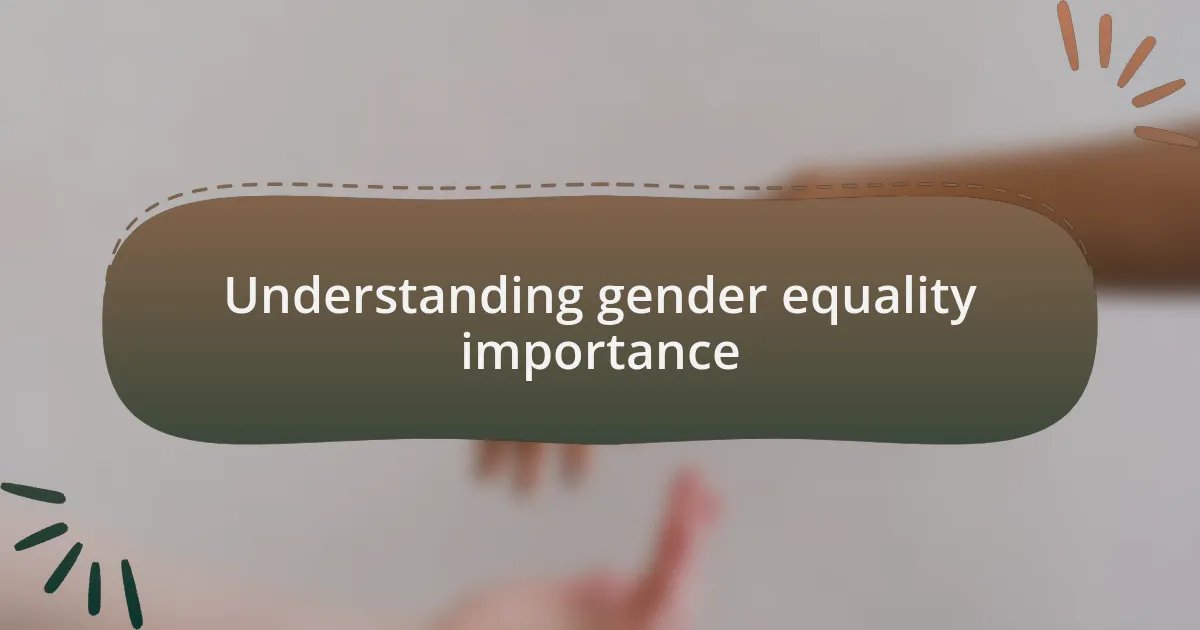
Understanding gender equality importance
Understanding the importance of gender equality is not just an ideological stance; it’s a fundamental aspect of creating a fair and just society. I remember a time in my own life when I witnessed a girl in my community being discouraged from pursuing a science career simply because of her gender. This situation ignited a passion in me to advocate for equal opportunities, and I often wonder how many untapped potentials we miss out on due to such biases.
When I think about gender equality, I reflect on how it impacts economic growth and societal health. Studies consistently show that when women are given equal access to education and jobs, communities thrive. Isn’t it puzzling how the exclusion of half the population from contributing fully can hold us back? Personally, I’ve seen teams flourish when diverse perspectives come together, which only emphasizes the necessity of gender equality for innovation.
Moreover, gender equality enriches our emotional landscapes. I’ve had conversations with both men and women who feel confined by traditional roles—men pressured to be the breadwinners and women expected to take on caregiving duties. These expectations create stress and limit personal growth. Shouldn’t we all have the freedom to choose our paths based on our individual strengths and aspirations rather than societal norms? The quest for gender equality is essentially about liberating all of us to be our authentic selves.
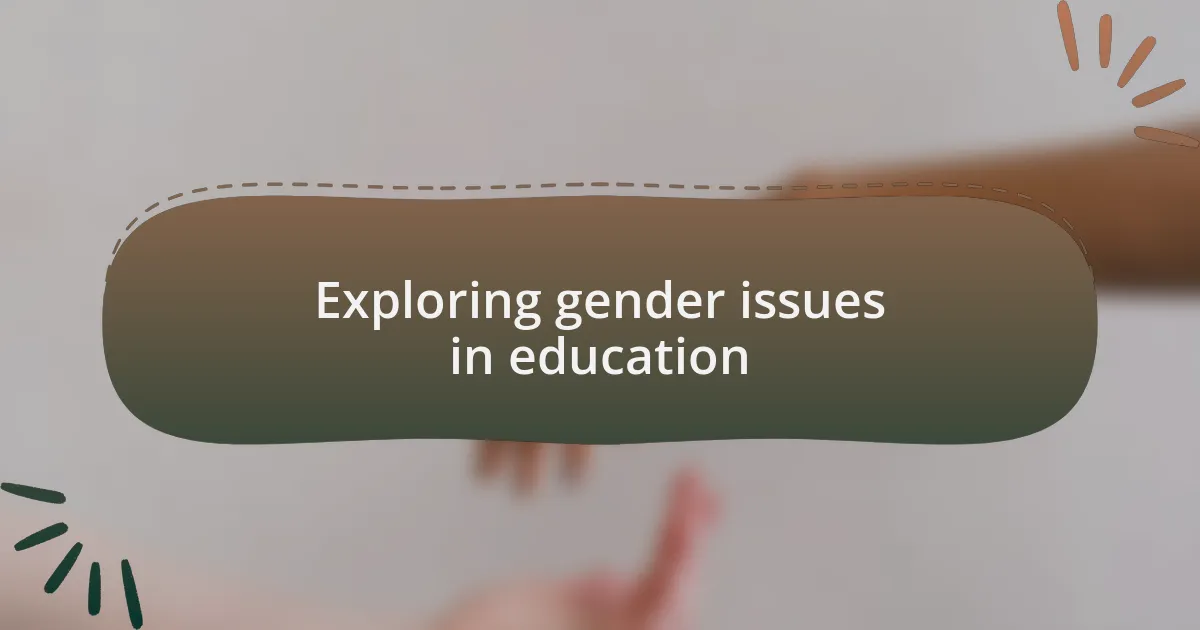
Exploring gender issues in education
One area where gender issues are prominently displayed is in the classroom setting. I recall a moment during a parent-teacher conference when I noticed how girls were often overlooked for leadership roles in group projects, while boys took the lead without hesitation. It struck me that these early experiences could shape their self-perception and ambition for years to come. How many young girls silently give up on their dreams because they internalize the belief that they shouldn’t take charge?
As I’ve engaged with parents about this issue, it became clear that many were simply unaware of the biases manifesting in classroom dynamics. One mother I spoke with shared how her daughter excelled in math but hesitated to join the school’s math club, fearing it was “too competitive” for girls. I couldn’t help but reflect on my own hesitations back in school, where I sometimes opted out of opportunities due to similar fears. It’s crucial for parents to recognize these patterns and encourage their children to break free from them.
Furthermore, the curriculum itself can play a big role in shaping perceptions of gender. I’ve examined textbooks that consistently depict certain professions as male-dominated, which further perpetuates stereotypes. If educators don’t actively address these representations, how can we expect students to envision a diverse world where anyone can aspire to be anything? Engaging parents in these discussions can help to create advocates for a more inclusive educational environment, ultimately fostering a generation that honors equality.
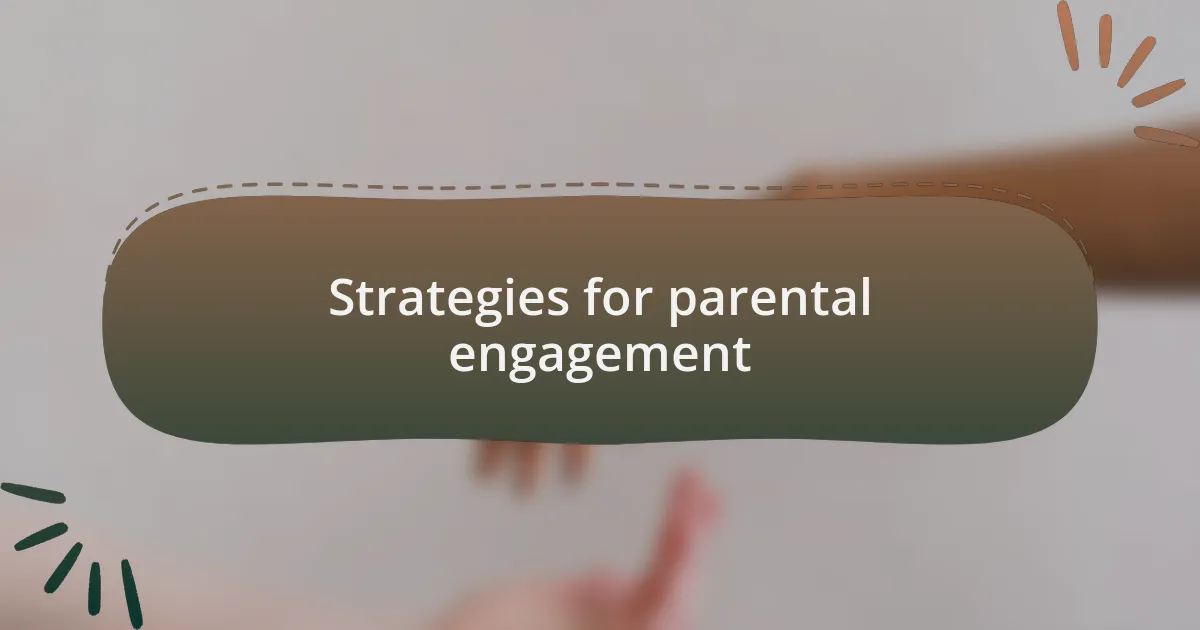
Strategies for parental engagement
One effective strategy for engaging parents in discussions about gender issues is hosting workshops that focus on the impact of language and expectations. I recall attending a session where parents were shown how subtle comments, like praising boys for being “tough” and girls for being “pretty,” can unconsciously create rigid gender roles. Afterward, many parents expressed surprise and a desire to change their language habits. Isn’t it fascinating how simple shifts in communication can foster a more inclusive mindset?
Another approach is creating parent-child activities centered around deconstructing gender stereotypes. I remember organizing a family movie night featuring films with strong female leads and diverse male characters. The conversations that erupted afterward were enlightening; parents reflected on how these narratives challenge traditional norms. Engaging families in this way not only opens dialogue but also strengthens bonds as they navigate gender issues together.
Finally, providing resources, like reading lists or discussion guides, can empower parents to continue these conversations at home. I often share articles and books that challenge conventional gender norms, and the feedback has been heartwarming. One father mentioned how he discussed a particular article with his daughter, sparking a passionate conversation about her own interests and aspirations. Isn’t it rewarding to see that these discussions can ignite a child’s curiosity and empower them to embrace their true selves?
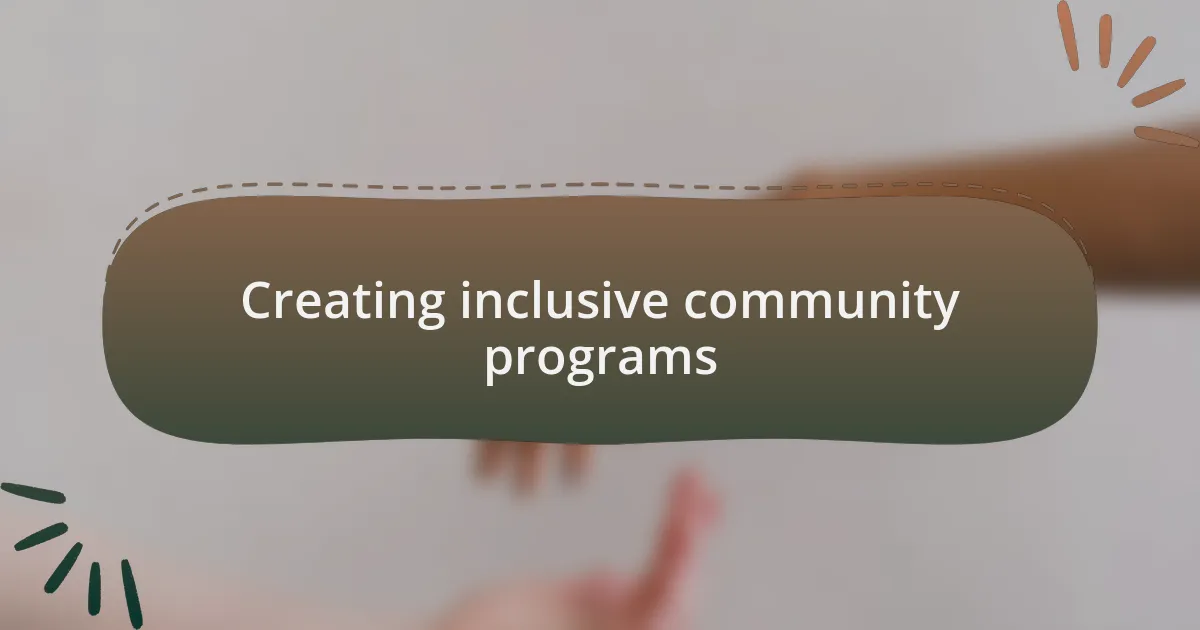
Creating inclusive community programs
Creating inclusive community programs involves intentional planning and collaboration among parents, educators, and community leaders. I once participated in a local initiative that invited parents to collaborate on designing workshops aimed at promoting gender equity. I was struck by how passionate everyone was about redefining their roles within our community; it was inspiring to see parents come together, sharing their concerns and ideas about raising aware children. Have you experienced such moments of unity?
Another effective method is to foster partnerships with local organizations to create safe spaces for open discussion. In one instance, we partnered with a local theater group to produce a series of plays that highlighted gender issues. The post-performance discussions were electric; parents and children alike felt comfortable sharing their thoughts and feelings. This collective experience truly emphasized how art can be a powerful vehicle for change.
Additionally, implementing mentorship programs that connect children with diverse role models can significantly enrich their understanding of gender dynamics. I recall a mentoring event where young boys and girls had the chance to meet professionals in non-traditional fields. Watching their eyes light up as they interacted with these role models was a poignant reminder of the impact visibility can have on shaping aspirations. Don’t you think that seeing a wider range of possibilities can help children dream beyond societal constraints?
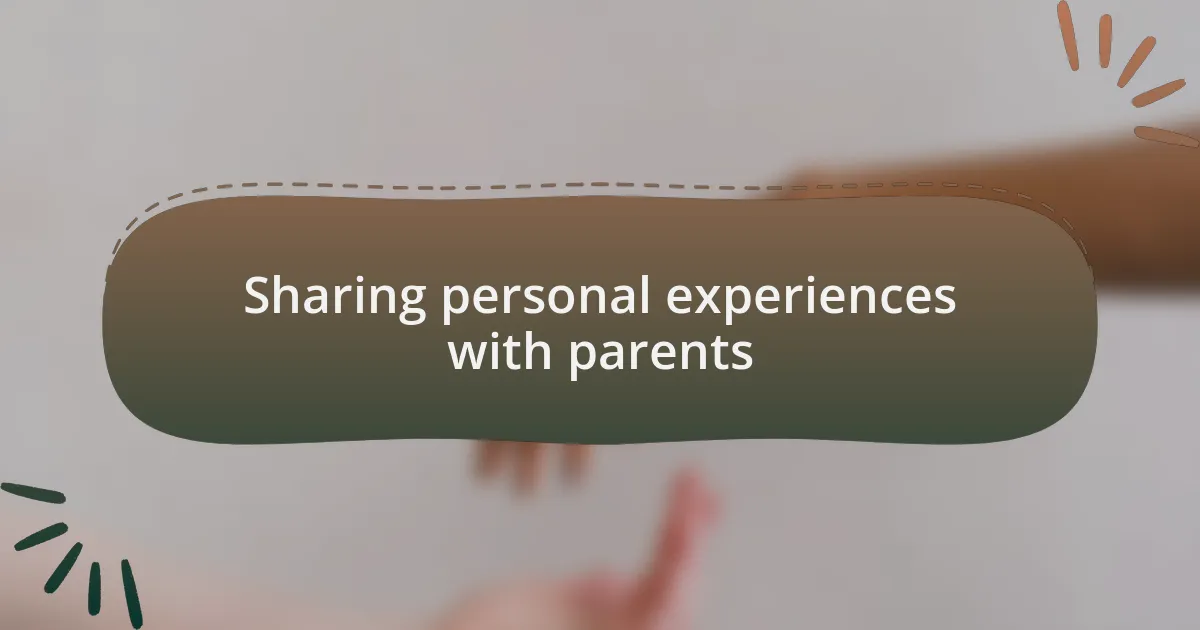
Sharing personal experiences with parents
Sharing personal experiences with parents often creates a deeper understanding of gender issues. I remember a candid conversation I had with my neighbor, a father of two, about the challenges he faced in teaching his daughters about equality. It was eye-opening for both of us when he shared how he struggled with societal expectations while wanting to encourage their independence.
In another instance, during a community meeting, I shared my journey of raising a son who respects women as equals. Parents were visibly engaged; one mother even admitted she’d never thought about how gender roles were impacting her own parenting. The genuine expressions of curiosity and concern sparked a dialogue that felt much more personal and relatable than any statistics could provide.
Additionally, when my friend hosted a gathering to discuss gender norms, it was remarkable how many parents opened up about their experiences. I felt a mix of pride and sadness as they recounted stories of their own childhoods, reflecting on how these narratives shaped their understanding of gender today. Isn’t it fascinating how sharing our stories can foster empathy and drive action within our communities?
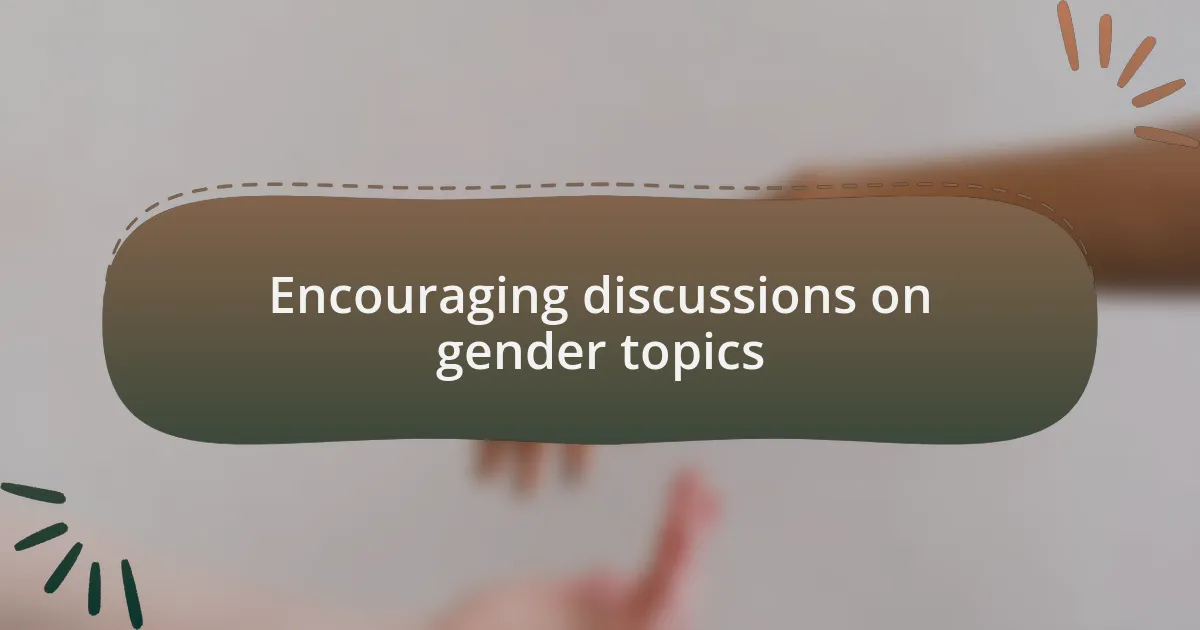
Encouraging discussions on gender topics
Encouraging discussions around gender topics often starts in the comfort of home. I vividly recall a weekend brunch where I encouraged my friends to reflect on their childhood experiences with gender expectations. The conversation quickly morphed into a lively debate on how these norms shaped our identities, highlighting not just the struggles but also the triumphs we had witnessed. It was a reminder of how sharing our perspectives can illuminate pathways for understanding.
I’ve noticed that creating safe spaces for these discussions is vital. At one point, I initiated a book club focused on literature that tackles gender issues. As parents shared their thoughts on the characters’ journeys, it became clear how literature could serve as a mirror to our own lives, prompting parents to reconsider the narratives they pass on to their children. Have you ever felt the shift in your own views while discussing a book? It’s powerful how stories can ignite conversations that lead us to challenge our assumptions.
Moreover, I’ve found that humor can break the ice around tough topics. During a family gathering, I shared a light-hearted story about my son’s perspective on dress-up play, which humorously highlighted how deeply ingrained gender roles can be. The laughter that ensued created an opening for parents to express their own experiences and worries, allowing us to dive deeper into serious discussions about gender socialization. Isn’t it amazing how a light-hearted moment can pave the way for meaningful dialogue?
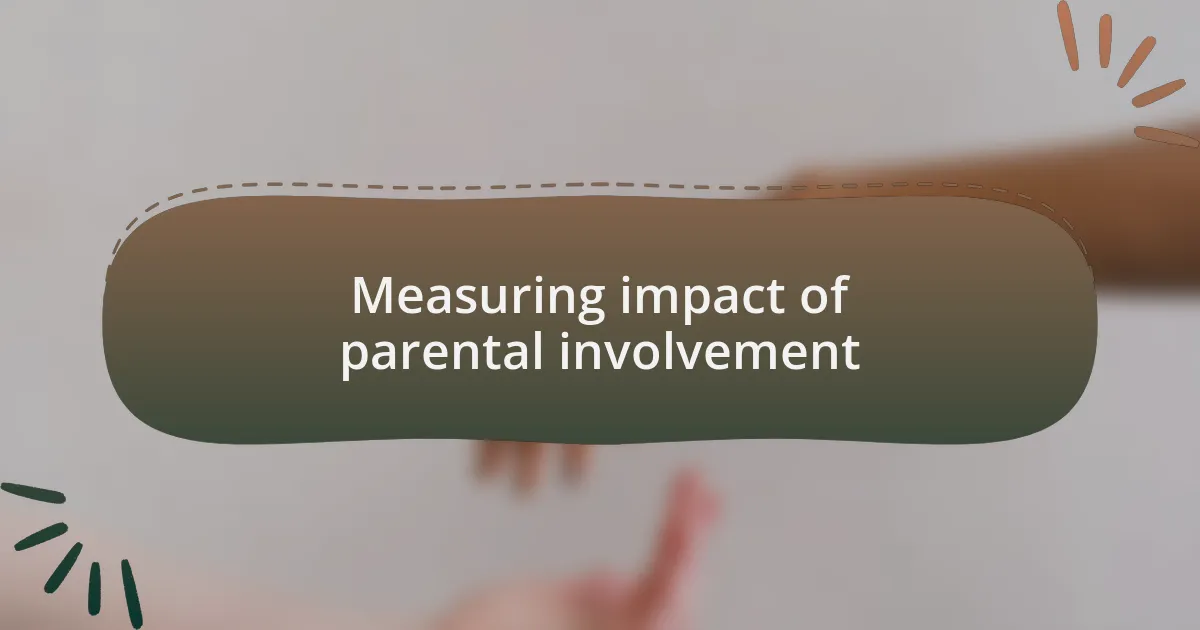
Measuring impact of parental involvement
Measuring the impact of parental involvement in gender discussions can be both enlightening and challenging. In my experience, after introducing gender-related topics at home, I noticed a shift in both my children’s attitudes and my own. For example, I tracked changes in their language and behavior over a few months, revealing how openly discussing gender expectations had encouraged them to question stereotypes they once accepted without thought.
One particular instance stands out; my daughter surprised me with her thoughts on a popular movie that reinforced traditional roles. I realized then that her newfound ability to critique media was a direct reflection of our ongoing conversations at home. Have you ever observed a moment when your child articulated a belief they formed from your discussions? Those moments are powerful indicators of a parent’s impact.
Assessing this influence also involves observing the dynamics within peer relationships. After a series of discussions, I noticed my son began to advocate for a friend who felt sidelined because of gender norms. It made me wonder: Could this advocacy be a ripple effect of our shared dialogues on equality? Witnessing these situations provides valuable insight into how parental involvement in gender issues shapes children’s interactions and their sense of justice in social contexts.